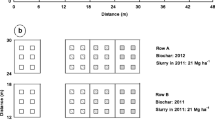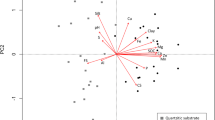Abstract
Peroxidases are enzymes that catalyze the oxidative cross-linking and polymerization of certain organic compounds by hydrogen peroxide and other organic peroxides. This study demonstrates that peroxidases are present in dew (droplets formed as the result of guttation) collected from Bermuda grass hybrids 419 and Tifway 2 [Cynodon dactylon (L.) × Cynodon transvaalensis Davy], which are warm-season C4 grasses, and Kentucky bluegrass (Poa pratensis L.), which is a cool-season C3 grass. Peroxidase activity [quantified with horseradish peroxidase (HRP) (activity 152 purpurogallin units/mg) as standard] in guttational fluids collected from grasses during early morning was in the 80 to 120 µg/L range. Isoelectric focusing was used to determine isoelectric points (pI) of the isozymes present in the Bermuda grass dew following dialysis and lyophilization of the collected dew. The pI values ranged from 4.3 to 8.3 with 14 isozymes being detected using guaiacol and hydrogen peroxide as substrates. Peroxidases also were extracted from soil supporting the growth of Bermuda grass. Peroxidases in these soils were most abundant in the top 5 cm layer (activity was in the 6.8 to 16 purpurogallin units/g range). Stability and activity of these peroxidases in the presence of fulvic and humic acids were evaluated. Compared to controls with no added humic substances, peroxidase activity was inhibited by a soil fulvic acid and prolonged by a humic acid. Field measurements indicated that peroxidase activity did not greatly decrease during the winter when the grass was dormant, indicating that the peroxidases released into the soil remain active for a considerable time. Based on results in these studies and previously determined dry and wet deposition of atmospheric peroxides, we estimate that peroxidase-catalyzed reactions in areas planted in these grasses may convert about 8 g C m-2 yr-1 of labile soil organic compounds to more persistent oligomers and polymers.
Similar content being viewed by others
References
Alperin MJ, Balesdent J, Benner RH, Blough NV, Christman RF, Druffel ERM, Frimmel FH, Guggenberger G, Repeta DJ, Richnow HH & Swift RS (1995) Group Report: How can we best characterize and quantify pools and fluxes of nonliving organic matter? In: Zepp RG & Sonntag, Ch (Eds) Role of nonliving organic matter in the earth's carbon cycle. Wiley: New York, pp 67-80
Abeles FB & Biles CL (1991) Characterization of peroxidases lignifying peach fruit endocarp. Plant Physiol. 96: 597-604
Blough NV & Zepp RG (1995) Reactive oxygen species in natural waters. In: Foote CS & Valentine JS (Eds) Reactive oxygen species in chemistry and biochemistry. Chapman & Hall: New York, pp 280-333
Ciais P, Tans PP, Trolier M, White JWC & Francey RJ (1995) A large Northern Hemisphere terrestrial CO2 sink indicated by the 13C/12C ratio of atmospheric CO2. Science 269: 1098-1102
Cooper WJ & Zepp RG (1990) Hydrogen peroxide decay in waters with suspended soils. Evidence for biologically mediated processes. Can. J. Fish. Aquat. Sci. 47: 888-893
Davidson E, Agren G, Daniel O, Emeis KC, Largeau C, Lee C, Mopper K, Oades JM, Reeburgh WS, Schimel DS & Zepp RG (1995) Group Report: What are the physical, chemical, and biological processes the control the formation and degradation of nonliving organic matter? In: Zepp RG & Sonntag Ch (Eds) Role of nonliving organic matter in the earth's carbon cycle. Wiley: New York, pp 305-324
Fugelstvedt JS, Jonson JE & Isaksen ISA (1994) Effects of reductions in stratospheric ozone on tropospheric chemistry through changes in photolysis rates. Tellus 46B: 172-192
Gamble, DS (1970) Titration curves of fulvic acid: the analytical chemistry of a weak acid polyelectrolyte. Can. J. Chem. 48: 2662-2669
Gao W, Wesley ML & Doskey PV (1993) Numerical modeling of the turbulent diffusion and chemistry of NOx, O3, isoprene, and other reactive trace gases in and above a forest canopy, J. Geophys. Res. 98D: 18,339-18,353
Gunz DW & Hoffmann MR (1990) Atmospheric chemistry of peroxides: A review, Atmos. Environ. 24A: 1601-1633
Hall BD & Claiborn CS (1997) Measurements of the dry deposition of peroxides to a Canadian boreal forest, J. Geophys. Res., submitted
Harkin JM & Obst JR (1973) Lignification in trees: Indication of exclusive peroxidase participation. Science 180: 296-298
Heikes BG, Kok GL, Walega JG & Lazrus AL (1987) H2O2, O3, and SO2 measurements in the lower troposphere over the eastern United States during fall. J. Geophys. Res. 92: 915-931
Ivanoff SS (1963) Guttation injuries of plants. Bot. Rev. 29: 202-228
Kleinman LI (1991) Seasonal dependence of boundary layer peroxide concentration, the low and high NOx regimes. J. Geophys. Res. 96D: 20,721-20,733
Liem HH, Cardencs F, Travavoli M, Poh-Fitzpatrick MB & Muller-Eberhard U (1979) Quantitative determination of hemoglobin and cytochemical staining for peroxidase using 3,3-,5,50tetramethylbenzidine dihydrochloride, a safe substitute for benzidine. Anal. Biochem. 30: 388-396
Lindner WA & Brand JM (1989) Peroxidases and other enzymes in maize guttation fluid. S. Afr. J. Sci. 85: 128-135
Magwa ML, Lindner WA & Brand JM (1993) Guttation fluid peroxidases from Helianthus annus. Phytochem. 32: 251-253
Melillo JM, Kicklighter DW, McGuire AD, Peterjohn WT & Newkirk KM (1995) Global change and its effects on soil organic carbon stocks. In: Zepp RG & Sonntag Ch (Eds) Role of nonliving organic matter in the earth's carbon cycle. Wiley: New York, pp 175-190
Moffett JW & Zafiriou OC (1990) Pathways for hydrogen peroxide decomposition in natural waters. Limnol. Oceanog. 35: 1221-1229
Pardieck DL, Bouwer EJ & Stone AT (1992) Hydrogen peroxide use to increase oxidant capacity for in situ bioremediation of contaminated soils and aquifers: A review. J. Contam. Hydrol. 9: 221-242
Polle A & Junkermann W (1994) Does atmospheric hydrogen peroxide contribute to damage to forest trees? Environ. Sci. Technol. 28: 812-815
Post WM, Anderson DW, Dahmke A, Houghton RA, Huc A-Y, Lassiter R, Najjar RG, Neue H-U, Pedersen TF, Trumbore SE & Vaikmäe R (1995) Group Report: What is the role of nonliving organic matter cycling on the global scale? In: Zepp RG & Sonntag Ch (Eds) Role of nonliving organic matter in the earth's carbon cycle. Wiley: New York, pp 155-174
Sakugawa H, Kaplan IR, Tsai W & Cohen Y (1990) Atmospheric hydrogen peroxide. Environ. Sci. Technol. 24: 1452-1462
Saunders BC, Holmes-Seidle AG & Stark BP (1964) Peroxidase: The properties and uses of a versatile enzyme and some related catalysts, Butterworths, London, 271 p
Serban A & Nissenbaum A (1986) Humic acid association with peroxidase and catalase. Soil Biol. Chem. 18: 41-44
Thompson AM, Owens MA, Stewart RW & Herwehe JA (1989) Sensitivity of tropospheric oxidants to global chemical and climate change. Atmos. Environ. 23: 516-532
Walcek CJA (1987) Theoretical estimate of O3 and H2O2 dry deposition over the Northeast United States. Atmos. Environ. 21: 2649-2659
Watkins BA, Parrish DD, Buhr S, Norton RB, Trainer M, Yee JE & Fehsenfeld FC (1995a) Factors influencing the concentration of gas phase hydrogen peroxide during the summer at Kinterbish, Alabama. J. Geophys. Res. 100D: 22,841-22,851
Watkins BA, Parrish DD, Trainer M, Norton RB, Yee JE, Fehsenfeld FC & Heikes BG (1995b) Factors influencing the concentration of gas phase hydrogen peroxide during the summer at Niwot Ridge, Colorado. J. Geophys. Res. 100D: 22,831-22,840
Wellinder KG, Rasmussen SK, Penel C & Greppin H (Eds) (1993) Plant Peroxidases: Biochemistry and Physiology. III. International Symposium Proceedings 1993. University of Copenhagen and University of Geneva. 497 p
Zepp RG, Skurlatov YI & Ritmiller LF (1988) Effects of aquatic humic substances on analysis for hydrogen peroxide using peroxidase-catalyzed oxidations of triarylmethanes or p-hydroxyphenylacetic acid, Environ. Technol. Lett. 9: 287-298
Author information
Authors and Affiliations
Rights and permissions
About this article
Cite this article
Kerstetter, R.E., Zepp, R.G. & Carreira, L. Peroxidases in grass dew derived from guttation: possible role in polymerization of soil organic matter. Biogeochemistry 42, 311–323 (1998). https://doi.org/10.1023/A:1005982226333
Issue Date:
DOI: https://doi.org/10.1023/A:1005982226333




